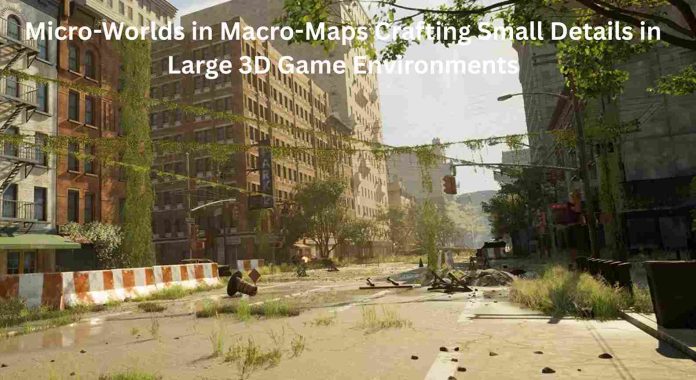In today’s expansive video games, it’s not just the vast landscapes or sprawling cities that captivate players—it’s the small, intentional details nestled within. From scattered tools on a bench to the rust on a forgotten car 3D model, it’s these micro-elements that breathe life into macro-worlds. In the world of 3D modeling games, the challenge lies in balancing large-scale environments with intricate detailing. Welcome to the art of building micro-worlds in macro-maps.
Why Micro-Worlds Matter in Macro 3D Game Environments
But what keeps players exploring are the tiny clues, interactive objects, and visual storytelling hidden in corners. These 3D game environments serve more than aesthetics—they aid immersion, spark curiosity, and guide exploration.
Creating micro-worlds—small, detailed areas within a vast landscape—requires a deep understanding of 3D environment modeling. Every barrel, desk, street corner, or wrecked car 3D model contributes to the illusion of a lived-in world. These miniature vignettes engage the player and encourage them to slow down and observe.
The Role of 3D Modeling Games in Environmental Storytelling
Props like worn-out shoes, broken fences, or scattered documents can tell a story of abandonment, conflict, or survival—without a single line of dialogue.
Integrating Micro-Details in Level Design
In 3D game environments, micro-details should support the game’s lore and gameplay:
A props 3D model like a broken sword stuck in a tree stump hints at a past duel.
Scorch marks on walls might suggest previous combat.
A 3D vehicle modeling element like a crashed van could indicate a failed escape attempt.
These subtle elements not only enrich visual variety but also create emotional touchpoints for players.
The Balance Between Macro and Micro in 3D Environment Modeling
Creating large environments demands efficient workflows, while detailing requires precision and time. That’s why developers rely on a layered approach:
1. Blockout Phase: Setting the Foundation
The blockout phase defines the general scale and player navigation in the 3D game environment. Here, designers focus on:
Terrain layout
Major landmarks
Pathways and vistas
At this stage, Hard Surface Modeling helps define geometric structures like bridges, buildings, and roads. Using simplified car 3D model placeholders can help map out streets or parking lots before adding detail.
2. Detailing Phase: Injecting Life with 3D Game Assets
Once the macro-map is established, it’s time to add micro-worlds. This involves populating the scene with:
Props 3D models: crates, tools, bottles, food, trash
Story-centric items: letters, drawings, photos
Environmental FX: decals, lighting variations, grime
High-quality 3D game assets can be reused smartly with slight alterations to avoid repetition and optimize performance.
Consistency in 3D Game Assets
To maintain a cohesive look, micro-elements must align with the overall art style. Whether the game is stylized or photorealistic, 3D modeling games must ensure all models—big or small—share a visual language.
Props 3D models should reflect:
Wear and tear consistent with the environment
Material types that make sense (wood, plastic, metal)
Correct scale relative to surroundings
Tools and Techniques to Enhance Micro-Worlds
Developers utilize a wide range of software and workflows to build intricate 3D game environments.
Hard Surface Modeling in Micro-Worlds
3D hard surface modeling plays a significant role in detailing elements like:
Vents, machinery, or industrial assets
Doors, windows, and pipes
Car 3D models and robotic props
Using tools like Blender, Maya, or 3ds Max, modelers can create detailed mechanical elements.
Texture Detailing and Decals
Textures are where micro-details truly shine. A basic props 3D model becomes storytelling gold when paired with:
Grime maps
Weathering effects
Rust, burn, or blood decals
Substance Painter, Quixel, and custom shaders allow artists to create realistic surface imperfections that tell stories, especially on car 3D models and urban surfaces.
Optimizing Micro-Worlds for Performance
Detailing can eat up resources quickly. Developers must consider:
Texture Atlases: Combining multiple textures into one
Baking Lighting: Pre-rendering shadows and highlights
A well-crafted props 3D model can be repurposed with new textures or slightly altered geometry.
Micro-Stories: Creating Engagement Beyond Gameplay
It’s not just about clutter. Every item in a 3D game environment should serve a purpose—be it environmental storytelling, gameplay hints, or atmosphere building.
Examples of effective micro-stories:
A diner scene where plates are half-eaten, and a jukebox still plays, suggesting sudden abandonment.
A desk with a photo frame knocked over and a cracked monitor, adding a human element to the environment.
These crafted micro-worlds enhance the depth of 3D game environments, giving players reasons to explore beyond objectives.
The Future: Procedural Generation Meets Hand-Crafted Detail
Procedural generation can fill landscapes with foliage or terrain, but 3D modeling games still rely on human creativity for meaningful details.
Future workflows may combine:
AI-based placement of props 3D models
Procedural decay or wear on 3D vehicle modeling assets
Yet, the hand of the artist will always be key in telling stories through detail.
Final Thoughts
In the ever-evolving world of 3D game environments, it’s the micro-worlds—crafted with care and intention—that transform spaces from playable to memorable. From a car 3D model rusting quietly in a forgotten alley to scattered props 3D models telling tales of survival or decay, these elements build emotional connections and player engagement.
Game developers who master both macro vision and micro execution—leveraging the power of 3D environment modeling, Hard Surface Modeling, and detailed 3D game assets—create immersive worlds that feel alive at every scale. And as technology grows, so does the potential for depth, detail, and discovery.
